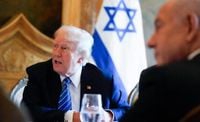On the evening of October 12, 2025, President Donald Trump is set to embark on a high-stakes journey to Israel and Egypt, marking a pivotal moment in the wake of a hard-won ceasefire between Israel and Hamas. The trip, announced just days after the truce took effect, is both a celebration of a historic peace deal and a somber acknowledgment of the painful cost exacted by two years of unrelenting conflict.
According to ABC News, former National Security Council Director Javed Ali discussed the significance of President Trump’s upcoming visit, emphasizing its timing in the immediate aftermath of the ceasefire. The truce, which went into effect at noon on Friday, October 10, 2025, followed a bloody chapter that began with Hamas’ surprise attack on October 7, 2023—a day that left at least 1,200 Israelis dead and hundreds taken hostage.
Trump, whose administration played a central role in brokering the agreement, is expected to join Israelis in "Hostage Square," where families and supporters are gathering to mark the end of hostilities. As reported by The New York Post, the atmosphere is one of both jubilation and mourning. American flags wave alongside posters of the president, a testament to the gratitude many feel for U.S. diplomatic efforts. Yet, the shadow of captivity lingers. Trump himself addressed the nation Friday night, warning the public about the grim realities facing surviving hostages and updating the world on the number of deceased. "They’re getting them now. They’re in some pretty rough places under earth. They’re in some pretty rough places where only a few people know where they are [in] some cases," Trump said. "So they’re getting them, and they’re also getting the bodies, approximately 28 bodies [of deceased hostages]. And some of those bodies are being unearthed right now as we speak. It’s a tragedy."
The next 72 hours are crucial. The ceasefire deal stipulates that Hamas must release its remaining hostages by noon Monday, October 13, 2025. As Fox News reported, about 20 hostages are believed to be alive, while the remains of 28 others are to be returned to their families. There is hope that some hostages could be freed overnight Sunday, just before Trump’s arrival.
In Tel Aviv, families of hostages wait anxiously for news. Hagai Angrest, whose son Matan is believed to be among the living, told Reuters, "We are very excited, waiting for our son and for all the 48 hostages. We are waiting for the phone call." The emotional stakes could hardly be higher.
The White House is scrambling to finalize the details of Trump’s journey. A senior official told The New York Post that the situation remains "very fluid," with last-minute decisions still being made about the president’s entourage and diplomatic agenda. What is clear, however, is that Trump will travel to Cairo to attend a summit organized by Egyptian President Abdel Fattah el-Sisi. There, he is expected to witness the formal signing of the agreement that officially ends the war. Trump also plans to chair a new "Board of Peace" tasked with overseeing a transitional government in Gaza—a move he hopes will foster lasting stability in the region.
The ceasefire has already begun to reshape life on the ground. According to Fox News, thousands of Palestinians started returning to their homes in the Gaza Strip on Saturday, October 11, 2025. The images are striking: massive columns of people moving north along the coastline, some by vehicle, others on foot. For many, the joy of survival is tempered by the devastation left behind. Nabila Basal, a Gaza resident, told Reuters, "It is an indescribable feeling; praise be to God. We are very, very happy that the war has stopped, and the suffering has ended." Yet, for others, the homecoming is bittersweet. Ismail Zayda, another resident, said, "Thank God my house is still standing. But the place is destroyed, my neighbors' houses are destroyed, entire districts have gone." In Khan Younis, Ahmed al-Brim lamented, "We went to our area. It was exterminated. We don't know where we will go after that."
The ceasefire agreement, as detailed by the Israel Defense Forces (IDF), required troops to reposition along updated deployment lines. IDF spokesman Avichay Adraee cautioned residents, "In accordance with the agreement, IDF troops will continue to be present in various areas of the Gaza Strip. You must avoid approaching IDF troops. Approaching them endangers your life." The truce grants Israel control of 53 percent of Gaza, a significant territorial shift that will shape the region’s future.
As the ceasefire settles in, the humanitarian toll becomes clearer. Palestinian health authorities reported that 100 bodies have been recovered across Gaza following the Israeli withdrawal, according to Reuters. The scars of war are everywhere—homes reduced to rubble, neighborhoods unrecognizable, families displaced with little more than the clothes on their backs. "We couldn't get the furniture, or clothes, or anything, not even winter clothes. Nothing is left," said Ahmed al-Brim.
Meanwhile, the political implications of the peace deal are reverberating far beyond the region. Trump’s leadership in brokering the agreement has led to suggestions that he be nominated for the Nobel Peace Prize. As reported by Getty Images, the president is expected to receive a hero’s welcome at Ben Gurion Airport, followed by a speech to the Israeli Knesset. The agreement also includes the release of 250 prisoners by Israel, a gesture aimed at building trust and facilitating reconciliation.
Trump has pledged to support the reconstruction of Gaza, emphasizing the role that wealthy regional actors could play. "Gaza is going to be rebuilt. And you have some very wealthy countries … over there. And it would take a small fraction of their wealth to do that," he said during his Oval Office remarks.
On the diplomatic front, White House Special Envoy Steve Witkoff and CENTCOM leader Adm. Brad Cooper were photographed visiting an IDF base in northern Gaza, underscoring ongoing U.S. engagement. Their presence signals a commitment to monitoring the truce and ensuring the safe return of hostages. The ceasefire’s success depends not only on political agreements but also on the ability of all parties to maintain security and prevent renewed violence.
As the world watches, the coming days will test the durability of this fragile peace. For the families of hostages, for residents returning to shattered neighborhoods, and for leaders on all sides, the hope is that this moment marks the beginning of a new chapter—one defined not by war, but by the arduous work of recovery and reconciliation.
With the stakes so high and emotions running deep, President Trump’s trip is more than a diplomatic mission. It is a symbol of what is possible when persistent negotiation, international pressure, and, yes, a bit of hope, come together to pull a region back from the brink.






